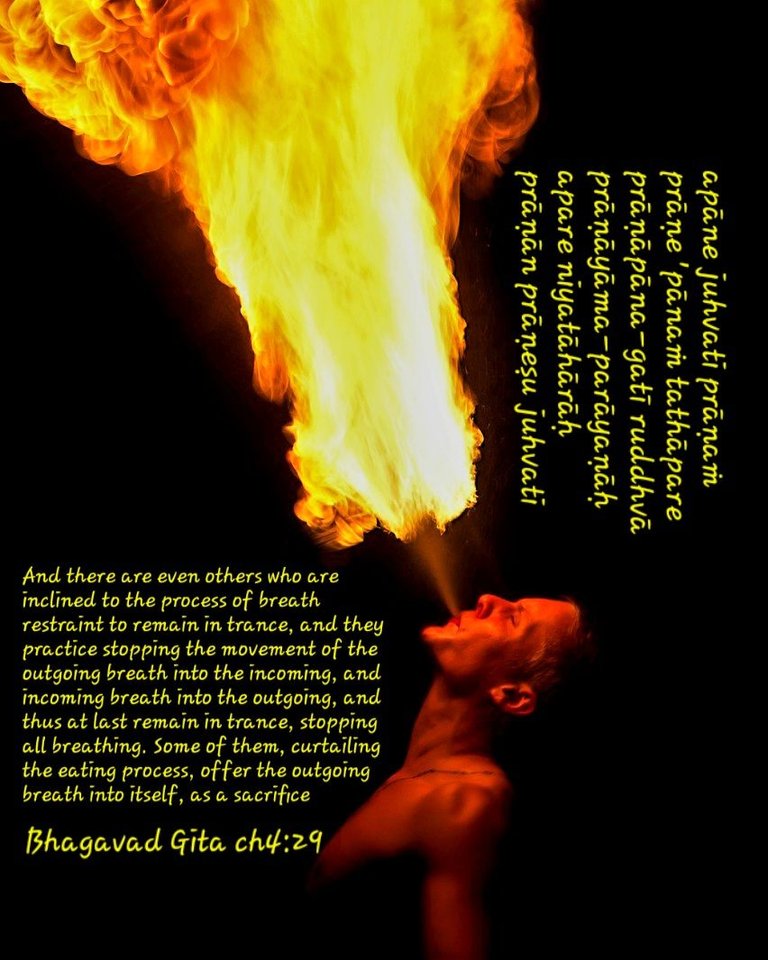Detailed breathing techniques have long been part of the arsenal of powerful weapons available to the aspiring spiritual warrior in the battle for truth and enlightenment against the forces of ignorance and darkness.

These yoga breathing techniques are the way that one can harness the wandering mind and focus it on the goal, or on becoming calm under stressful conditions or to steady the concentration in meditation.
Some of these techniques include skull breathing (kapalbandhi), nadi shodhana (purifying the channels), and holding the breath between inhalation and exaltation (puraka, kumbhaka, rechaka).
This latter involves breathing out on a count of four, holding for a count of eight, and breathing in for four, and holding for eight (or any variation on these counts). The holding part is called kumbhaka, which comes from the Sanskrit work for pot or vessel (as seen in Kumbha Mela , which is happening as i write this). The yogi is harnessing the simple process of breathing and thereby harnessing the mind.
By controlling the mind, the senses are also controlled. Also, with practice, the yogi can enter a state of deep meditation by mechanically regulating the breathing.
Furthermore, the ancient yoga texts even describe how by slowing down the breath, one can slow down the aging process and live longer. But this may be a very rare and difficult process taking many years and not possibles for just anyone.
Ultimately living longer is not so important on the path of liberation or awakening of consciousness, so it's not a major focus. There are more valuable goals, namely mastering the mind and senses so that deeper focus and meditation on the source are possible.
That will facilitate a return to the source, the actual goal of yoga and breath control.

Bhagavad Gita ch4:29
apāne juhvati prāṇaṁ
prāṇe 'pānaṁ tathāpare
prāṇāpāna-gatī ruddhvā
prāṇāyāma-parāyaṇāḥ
apare niyatāhārāḥ
prāṇān prāṇeṣu juhvati
SYNONYMS
apāne—air which acts downward; juhvati—offers; prāṇam—air which acts outward; prāṇe—in the air going outward; apānam—air going downward; tathā—as also; apare—others; prāṇa—air going outward; apāna—air going downward; gatī—movement; ruddhvā—checking; prāṇāyāma—trance induced by stopping all breathing; parāyaṇāḥ—so inclined; apare—others; niyata—controlled; āhārāḥ—eating; prāṇān—outgoing air; prāṇeṣu—in the outgoing air; juhvati—sacrifices
TRANSLATION
And there are even others who are inclined to the process of breath restraint to remain in trance, and they practice stopping the movement of the outgoing breath into the incoming, and incoming breath into the outgoing, and thus at last remain in trance, stopping all breathing. Some of them, curtailing the eating process, offer the outgoing breath into itself, as a sacrifice.
PURPORT
This system of yoga for controlling the breathing process is called prāṇāyāma, and in the beginning it is practiced in the haṭha-yoga system through different sitting postures. All of these processes are recommended for controlling the senses and for advancement in spiritual realization. This practice involves controlling the air within the body to enable simultaneous passage in opposite directions. The apāna air goes downward, and the prāṇa air goes up. The prāṇāyāma yogī practices breathing the opposite way until the currents are neutralized into pūraka, equilibrium. Similarly, when the exhaled breathing is offered to inhaled breathing, it is called recaka. When both air currents are completely stopped, it is called kumbhaka-yoga. By practice of kumbhaka-yoga, the yogīs increase the duration of life by many, many years. A Kṛṣṇa conscious person, however, being always situated in the transcendental loving service of the Lord, automatically becomes the controller of the senses. His senses, being always engaged in the service of Kṛṣṇa, have no chance of becoming otherwise engaged. So at the end of life, he is naturally transferred to the transcendental plane of Lord Kṛṣṇa; consequently he makes no attempt to increase his longevity. He is at once raised to the platform of liberation. A Kṛṣṇa conscious person begins from the transcendental stage, and he is constantly in that consciousness. Therefore, there is no falling down, and ultimately he enters into the abode of the Lord without delay. The practice of reduced eating is automatically done when one eats only Kṛṣṇa prasādam, or food which is offered first to the Lord. Reducing the eating process is very helpful in the matter of sense control. And without sense control there is no possibility of getting out of the material entanglement.
Reference: Bhagavad Gita As It Is, translation and commentary by Swami A C Bhaktivedanta, original MacMillan 1972 edition, freely available at prabhupadabooks.com.
Image: https://pixabay.com/photos/pen-colored-pencil-to-learn-5112463/
https://pixabay.com/photos/fire-breathing-person-man-2192625/
Edited and published from my mobile device onto the Hive blockchain for aspiring masters of breath.
Discord Server.This post has been manually curated by @steemflow from Indiaunited community. Join us on our
Do you know that you can earn a passive income by delegating to @indiaunited. We share more than 100 % of the curation rewards with the delegators in the form of IUC tokens. HP delegators and IUC token holders also get upto 20% additional vote weight.
Here are some handy links for delegations: 100HP, 250HP, 500HP, 1000HP.
100% of the rewards from this comment goes to the curator for their manual curation efforts. Please encourage the curator @steemflow by upvoting this comment and support the community by voting the posts made by @indiaunited..
This post received an extra 10.00% vote for delegating HP / holding IUC tokens.